2022年中考英语二轮专题复习课件:专题十 非谓语动词(共有PPT48张)
文档属性
| 名称 | 2022年中考英语二轮专题复习课件:专题十 非谓语动词(共有PPT48张) |  | |
| 格式 | zip | ||
| 文件大小 | 422.5KB | ||
| 资源类型 | 教案 | ||
| 版本资源 | 人教新目标(Go for it)版 | ||
| 科目 | 英语 | ||
| 更新时间 | 2022-01-05 08:35:13 | ||
图片预览

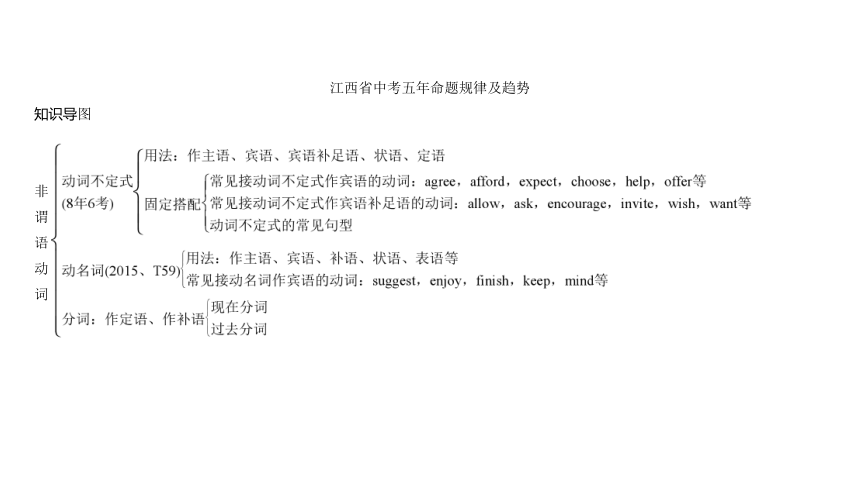



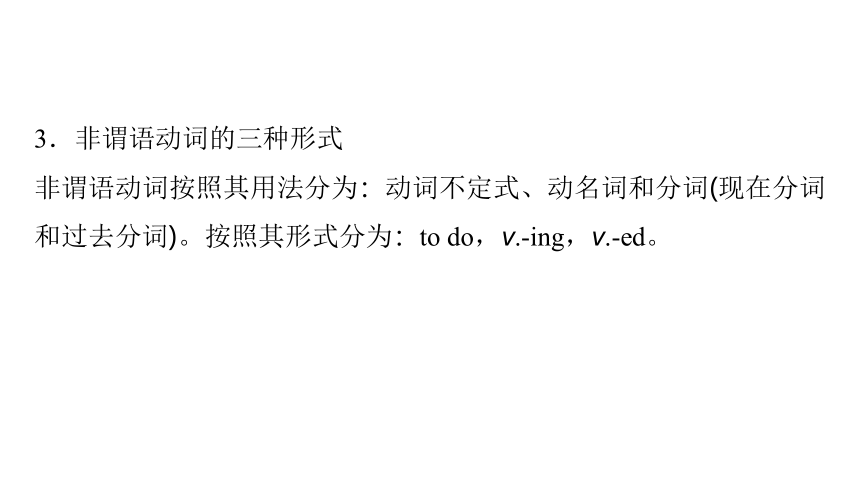
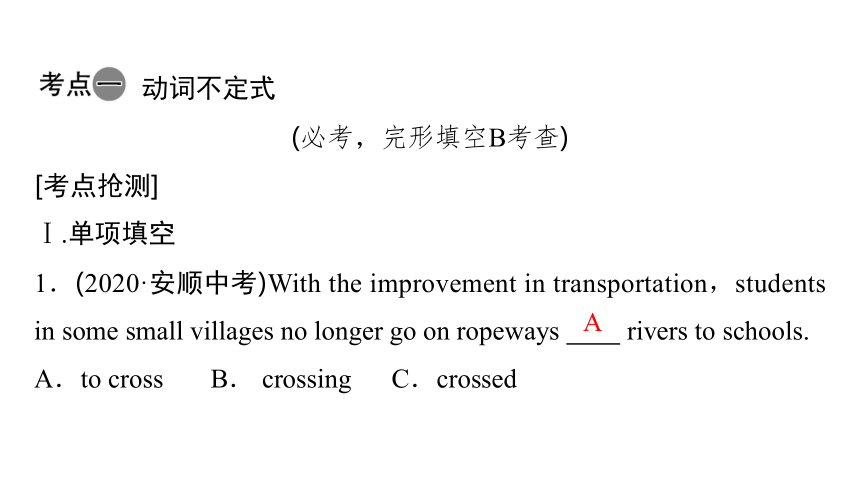
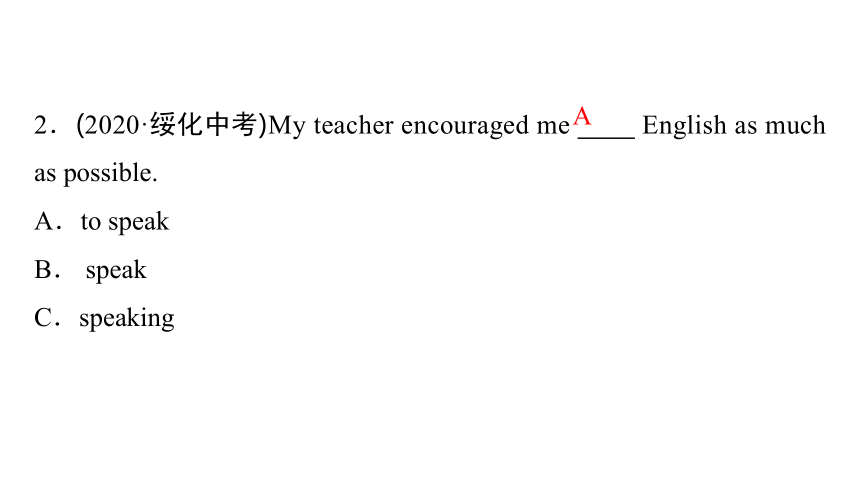
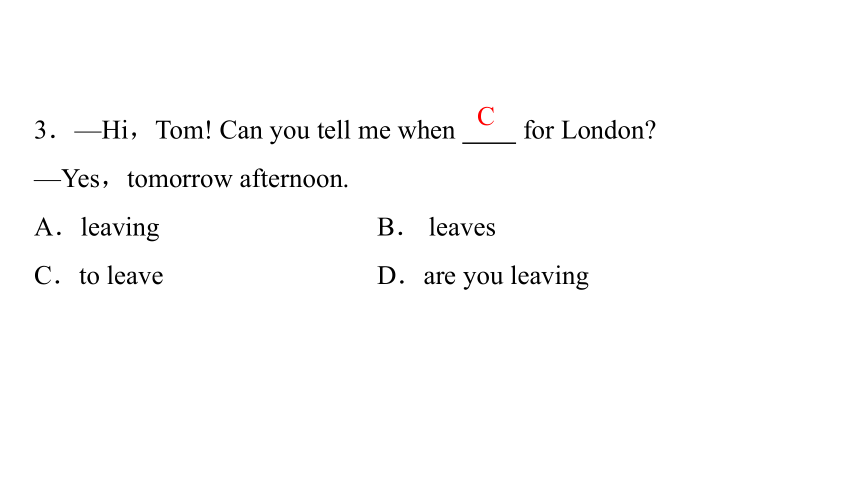
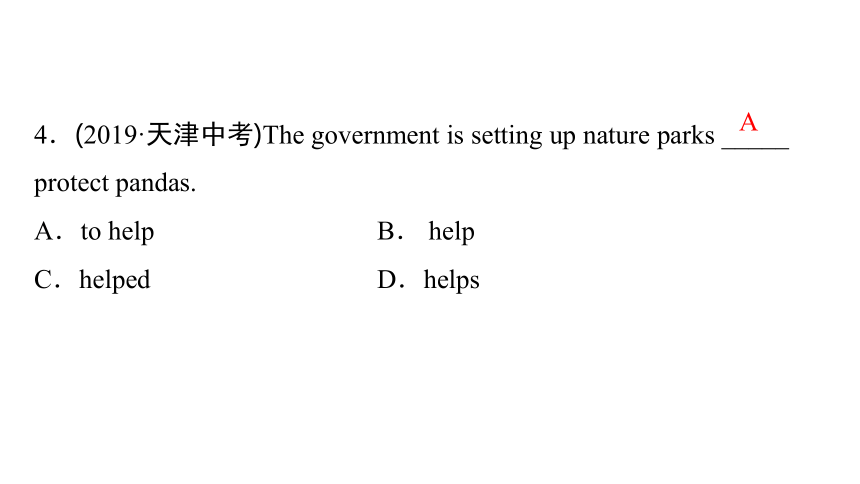
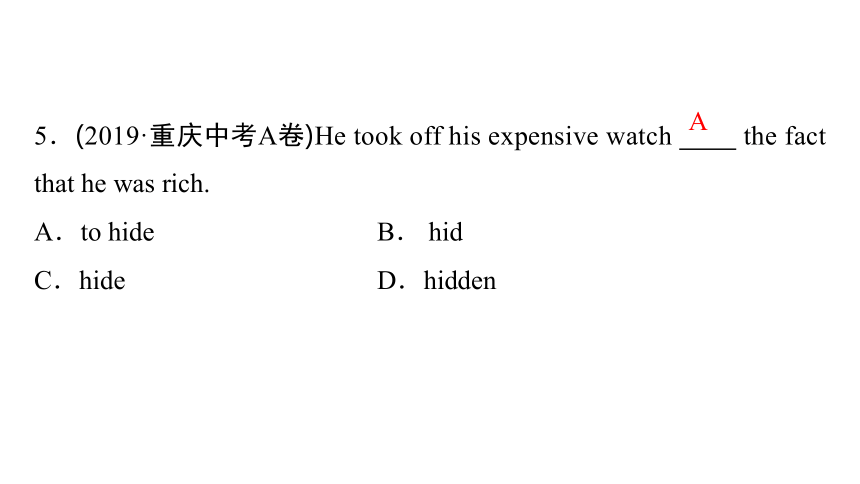
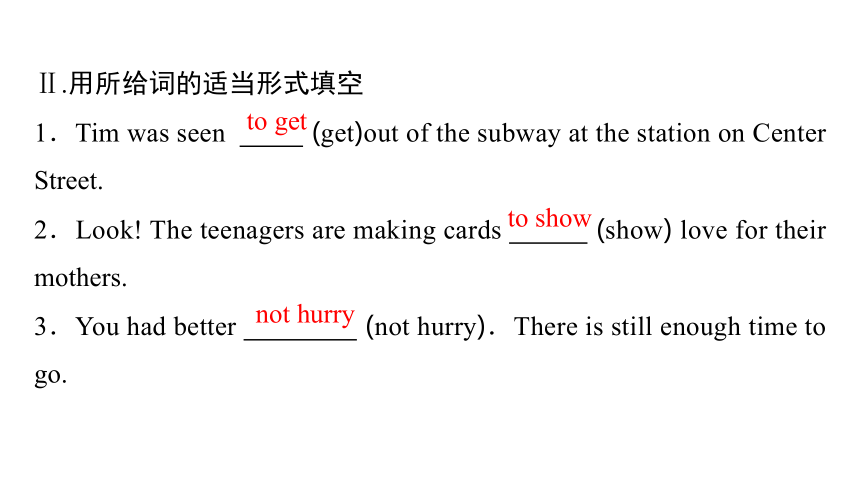
文档简介
(共48张PPT)
专题十 非谓语动词
江西省中考五年命题规律及趋势
知识导图
非
谓
语
动
词
总结与预测:从近五年江西中考来看,对非谓语动词的考查主要集中在不定式作宾语和目的状语上,特别是不定式表示目的。这一知识点的考查主要是在完形B题型中。解答此类题的关键在于:熟记一些固定搭配以及常见的可以跟动词不定式和动名词作宾语的动词及其不同含义,同时掌握动词不定式和动名词在句中所作的成分。
非谓语动词的定义及句法功能
1.非谓语动词的定义
非谓语动词是在句子中充当除谓语以外的句子成分的动词形式。
2.非谓语动词的句法功能
非谓语动词在句中可以充当主语、宾语、表语、补语、定语或状语等成分,即动词的非谓语形式除了不能独立作谓语外,可以承担句子的任何成分。如:
To see is to believe.(作主语和表语)眼见为实。
The boy likes walking to school.(作宾语)那个男孩喜欢步行去学校。
Don't keep us waiting for a long time.(作宾语补足语)不要让我们等得太久。
3.非谓语动词的三种形式
非谓语动词按照其用法分为:动词不定式、动名词和分词(现在分词和过去分词)。按照其形式分为:to do,v. ing,v. ed。
动词不定式
(必考,完形填空B考查)
[考点抢测]
Ⅰ.单项填空
1.(2020·安顺中考)With the improvement in transportation,students in some small villages no longer go on ropeways rivers to schools.
A.to cross B. crossing C.crossed
A
2.(2020·绥化中考)My teacher encouraged me English as much as possible.
A.to speak
B. speak
C.speaking
A
3.—Hi,Tom! Can you tell me when for London
—Yes,tomorrow afternoon.
A.leaving B. leaves
C.to leave D.are you leaving
C
4.(2019·天津中考)The government is setting up nature parks _____
protect pandas.
A.to help B. help
C.helped D.helps
A
5.(2019·重庆中考A卷)He took off his expensive watch the fact that he was rich.
A.to hide B. hid
C.hide D.hidden
A
Ⅱ.用所给词的适当形式填空
1.Tim was seen (get)out of the subway at the station on Center Street.
2.Look! The teenagers are making cards (show) love for their mothers.
3.You had better (not hurry).There is still enough time to go.
to get
to show
not hurry
4.If you are really tired,you can stop (have)a rest for 10 minutes.
5.—How long does it take you (drive)to school every day
—About half an hour.
6.It's important for us (protect)the environment.
7.I don't have a partner (practice)English with.
8.After two hours' drive,the driver decided (stop)and have a rest.
to have
to drive
to protect
to practice
to stop
[考点剖析]
动词不定式不能单独作谓语,其形式不随主语的人称、数的变化而变化,其基本构成是“to+动词原形”,有时也可省略不定式符号to,否定形式为“not to+动词原形”。
一、动词不定式的用法
1.作主语。不定式作主语往往用形式主语it代替,作为句子真正主语的不定式则被后置。
常用句型:It's+adj.+(for/of sb.) to do sth.。如:
It's nice of you to take pictures for us.你真好,给我们照相。
2.作表语。可放在be动词之后作表语。如:
My work is to clean the room every day.我的工作是每天打扫房间。
3.作宾语。常接不定式作宾语的动词有:
decide“决定”,expect“期望”,choose“选择”,hope“希望”,pretend“假装”,try“尽力”等。如:
Have you decided to go on a trip to London this summer vacation?你决定今年暑假去伦敦旅行了吗?
4.作宾语补足语。常接不定式作宾语补足语的动词有:
ask“要求”,tell“告诉”,want“想要”,teach“教”,wish“希望”,help“帮助”,warn“警告”,invite“邀请”,encourage“鼓励”等。如:
Tina told her sister to turn down the TV.蒂娜告诉她姐姐把电视机的音量调小点。
5.作定语。动词不定式作定语时,要置于被说明修饰的名词之后,作后置定语。如:
I am not free now.I have lots of things to do.我现在没有空。我有很多事要做。
6.作状语。主要作目的状语,也可作结果状语和原因状语。如:
They will go to the station to meet the guests.他们将去车站会见客人。(目的状语)
Paul is too excited to say anything.保罗激动得说不出话来了。(结果状语)
I am sorry to hear that your mother was ill in hospital.听说你妈妈生病住院了我很难过。(原因状语)
注意:在使役动词make,let,have和感官动词see,hear,watch,notice,feel等词后,要把不定式结构中的to省略。如:
I saw our English teacher enter the office just now.刚才我看到我们的英语老师走进办公室了。
二、常见的只能跟不定式的动词
tell sb.to do sth.告诉某人做某事
ask sb.to do sth.要求某人做某事
invite sb.to do sth.邀请某人做某事
want sb.to do sth.想要某人做某事
teach sb.to do sth.教某人做某事
allow sb.to do sth.允许某人做某事
force sb.to do sth.强迫某人做某事
expect sb.to do sth.期望某人做某事
advise sb.to do sth.建议某人做某事
promise to do sth.承诺做某事
would like sb.to do sth.想要某人做某事
wish to do sth.希望做某事
decide to do sth.决定做某事
refuse to do sth.拒绝做某事
learn to do sth.学习做某事
plan to do sth.计划做某事
persuade sb.to do sth.说服某人做某事
三、动词不定式与动名词作宾语的区别
1.有些动词既可接不定式也可接动名词形式作宾语,但表达的意思不同。举例如下:
stop to do sth.停下来去做另一件事
stop doing sth.停止正在做的事
try to do sth.尽力去做某事
try doing sth.尝试做某事
forget to do sth.忘了去做某事(未做)
forget doing sth.忘了做过某事
remember to do sth.记得去做某事(未做)
remember doing sth.记得做过某事
need to do sth.需要去做某事(主动含义)
need doing sth.需要做某事(被动含义)
2.感官动词后接不带to的不定式或现在分词
感官动词后既可接不带to的不定式,也可接现在分词;接不带to的不定式时指“(看到、听到、见到)全过程”,接现在分词时指“瞬间动作”。如:
I heard the girl singing in the next room.我听到那个女孩正在隔壁房间里唱歌。
I always hear the girl sing in the next room.我经常听到那个女孩在隔壁房间里唱歌。
四、动词不定式的特殊句型
1.too...to...表示“太……而不能……”。如:
The boy is too young to look after himself.这个男孩太小不能照顾自己。
2....enough to...表示“……足够……”。如:
He is old enough to go to school.他到了上学的年龄了。
3.Why don't you +不带to的不定式?=Why not+不带to的不定式?如:
Why don't you get her a photo album?=Why not get her a photo album?为什么不给她买个相册呢?
4.had better (+not)+不带to的不定式。如:
You'd better not stay there today.你今天最好别待在那儿。
5.prefer to do sth.rather than do sth.“宁愿做某事而不愿做某事”。如:
She prefers to receive a small gift that has some thought behind it rather than receive a lot of money.她宁愿收到一份有意义的小礼物也不愿收到一大笔钱。
动名词和分词
(近五年未考)
[考点抢测]
Ⅰ.单项填空
1.As we all know,it's not polite to keep others for a long time.
A.wait B. waited
C.to wait D.waiting
D
2.The new treatments by Norman Bethune helped a number of soldiers.
A.invent B. invents
C.inventing D.invented
D
3.Why not an English club to practice English
A.to join;to speak B. join;speaking
C.join;to speak D.to join;speaking
B
4.(原创题)— a volunteer is great.
—I think so. Some of us want volunteers for the 2022 Beijing Winter Olympics.
A.Being;being B. To be;being
C.Being;to be D.Be;to be
C
5.Would you mind the door It's so windy and I feel so cold.
A.closing B. opening
C.to close D.to open
A
Ⅱ.用所给动词的适当形式填空
1.Last weekend,the Greens had great fun (swim)at Water World.
2.I remember (meet)all of you in Grade 7.
swimming
meeting
3.The (break)window needs repairing.
4. (play)computer games too much is bad for your eyes.
5.(原创题)Nowadays more and more people enjoy (watch) cartoon films such as Ne Zha(《哪吒》)and Spirited Away(《千与千
寻》).
broken
Playing
watching
[考点剖析]
一、动名词
动名词由“动词原形+ ing”构成,与该动词的现在分词同形。动名词既有动词的性质,也有名词的性质。
1.作主语。如:
Climbing mountains is really fun.爬山真是有趣。
注意:动名词作主语和动词不定式作主语,在很多情况下可以通用。
2.作宾语。如:
Have you finished reading the book 你读完这本书了吗?
常接动名词作宾语的动词或短语有:
enjoy doing sth.喜欢做某事
finish doing sth.完成做某事
consider doing sth.考虑做某事
miss doing sth.错过做某事
keep doing sth.持续做某事
mind doing sth.介意做某事
practice doing sth.练习做某事
suggest doing sth.建议做某事
be busy doing sth.忙于做某事
feel like doing sth.想要做某种
put off doing sth.推迟做某事
have fun doing sth.做某事很开心
give up doing sth.放弃做某事
can't help doing sth.情不自禁做某事
avoid doing sth.避免做某事
be used to doing sth.习惯于做某事
be worth doing sth.值得做某事
be afraid of doing sth.害怕做某事
be proud of doing sth.做某事感到自豪
be interested in doing sth.有兴趣做某事
keep/stop/prevent...from doing sth.阻止做某事
look forward to doing sth.期待做某事
3.作表语。如:
The nurse's job is taking care of the patients.护士的工作是照顾病人。
4.作定语。如:
I often go to the reading room.我经常去阅览室。
注意:有些动词后既可接不定式又可接v. ing形式,但表达的意义不同。
二、分词
分词分为现在分词和过去分词两种。现在分词(v. ing)有主动、进行之意;过去分词(v. ed)有被动、完成之意。
1.作定语。如:
China is a developing country. America is a developed country.中国是发展中国家,美国是发达国家。
I know the boy called Li Ming.我认识那个叫李明的男孩。
2.作表语。如:
The book is interesting. I'm interested in it.这本书很有趣,我对它感兴趣。
3.作宾语补足语。如:
I saw her going upstairs.我看见她正在上楼。
I want to have some photos taken.我想拍几张照片。
4.作状语。如:
Talking and laughing,they went into the room.他们有说有笑地走进了房间。
5.现在分词与过去分词的区别
(1)在语态上,现在分词表示主动,过去分词表示被动。如:
a moving film 一场感人的电影
the moved people 被感动的人们
(2)在时间上,现在分词表示正在进行的动作,过去分词表示已经完成的动作。 如:
the developing country 发展中国家
the developed country 发达国家
6.易混结构
使役动词(make,keep,let,have等)易混结构的区分,如have sb. doing sth.与have sth.done的区别:
(1)have sb.doing sth.意为“让某人一直做某事”,doing这个动作具有持续性。如:
The mother had the sons standing all morning.妈妈让儿子们罚站了一上午。
(2)have sth. done 意为“让某人做某事”,相当于“ask sb.to do sth.”,done表示让他人完成,有被动之意。如:
I had my computer repaired yesterday.昨天我让人修理了我的电脑。
专题十 非谓语动词
江西省中考五年命题规律及趋势
知识导图
非
谓
语
动
词
总结与预测:从近五年江西中考来看,对非谓语动词的考查主要集中在不定式作宾语和目的状语上,特别是不定式表示目的。这一知识点的考查主要是在完形B题型中。解答此类题的关键在于:熟记一些固定搭配以及常见的可以跟动词不定式和动名词作宾语的动词及其不同含义,同时掌握动词不定式和动名词在句中所作的成分。
非谓语动词的定义及句法功能
1.非谓语动词的定义
非谓语动词是在句子中充当除谓语以外的句子成分的动词形式。
2.非谓语动词的句法功能
非谓语动词在句中可以充当主语、宾语、表语、补语、定语或状语等成分,即动词的非谓语形式除了不能独立作谓语外,可以承担句子的任何成分。如:
To see is to believe.(作主语和表语)眼见为实。
The boy likes walking to school.(作宾语)那个男孩喜欢步行去学校。
Don't keep us waiting for a long time.(作宾语补足语)不要让我们等得太久。
3.非谓语动词的三种形式
非谓语动词按照其用法分为:动词不定式、动名词和分词(现在分词和过去分词)。按照其形式分为:to do,v. ing,v. ed。
动词不定式
(必考,完形填空B考查)
[考点抢测]
Ⅰ.单项填空
1.(2020·安顺中考)With the improvement in transportation,students in some small villages no longer go on ropeways rivers to schools.
A.to cross B. crossing C.crossed
A
2.(2020·绥化中考)My teacher encouraged me English as much as possible.
A.to speak
B. speak
C.speaking
A
3.—Hi,Tom! Can you tell me when for London
—Yes,tomorrow afternoon.
A.leaving B. leaves
C.to leave D.are you leaving
C
4.(2019·天津中考)The government is setting up nature parks _____
protect pandas.
A.to help B. help
C.helped D.helps
A
5.(2019·重庆中考A卷)He took off his expensive watch the fact that he was rich.
A.to hide B. hid
C.hide D.hidden
A
Ⅱ.用所给词的适当形式填空
1.Tim was seen (get)out of the subway at the station on Center Street.
2.Look! The teenagers are making cards (show) love for their mothers.
3.You had better (not hurry).There is still enough time to go.
to get
to show
not hurry
4.If you are really tired,you can stop (have)a rest for 10 minutes.
5.—How long does it take you (drive)to school every day
—About half an hour.
6.It's important for us (protect)the environment.
7.I don't have a partner (practice)English with.
8.After two hours' drive,the driver decided (stop)and have a rest.
to have
to drive
to protect
to practice
to stop
[考点剖析]
动词不定式不能单独作谓语,其形式不随主语的人称、数的变化而变化,其基本构成是“to+动词原形”,有时也可省略不定式符号to,否定形式为“not to+动词原形”。
一、动词不定式的用法
1.作主语。不定式作主语往往用形式主语it代替,作为句子真正主语的不定式则被后置。
常用句型:It's+adj.+(for/of sb.) to do sth.。如:
It's nice of you to take pictures for us.你真好,给我们照相。
2.作表语。可放在be动词之后作表语。如:
My work is to clean the room every day.我的工作是每天打扫房间。
3.作宾语。常接不定式作宾语的动词有:
decide“决定”,expect“期望”,choose“选择”,hope“希望”,pretend“假装”,try“尽力”等。如:
Have you decided to go on a trip to London this summer vacation?你决定今年暑假去伦敦旅行了吗?
4.作宾语补足语。常接不定式作宾语补足语的动词有:
ask“要求”,tell“告诉”,want“想要”,teach“教”,wish“希望”,help“帮助”,warn“警告”,invite“邀请”,encourage“鼓励”等。如:
Tina told her sister to turn down the TV.蒂娜告诉她姐姐把电视机的音量调小点。
5.作定语。动词不定式作定语时,要置于被说明修饰的名词之后,作后置定语。如:
I am not free now.I have lots of things to do.我现在没有空。我有很多事要做。
6.作状语。主要作目的状语,也可作结果状语和原因状语。如:
They will go to the station to meet the guests.他们将去车站会见客人。(目的状语)
Paul is too excited to say anything.保罗激动得说不出话来了。(结果状语)
I am sorry to hear that your mother was ill in hospital.听说你妈妈生病住院了我很难过。(原因状语)
注意:在使役动词make,let,have和感官动词see,hear,watch,notice,feel等词后,要把不定式结构中的to省略。如:
I saw our English teacher enter the office just now.刚才我看到我们的英语老师走进办公室了。
二、常见的只能跟不定式的动词
tell sb.to do sth.告诉某人做某事
ask sb.to do sth.要求某人做某事
invite sb.to do sth.邀请某人做某事
want sb.to do sth.想要某人做某事
teach sb.to do sth.教某人做某事
allow sb.to do sth.允许某人做某事
force sb.to do sth.强迫某人做某事
expect sb.to do sth.期望某人做某事
advise sb.to do sth.建议某人做某事
promise to do sth.承诺做某事
would like sb.to do sth.想要某人做某事
wish to do sth.希望做某事
decide to do sth.决定做某事
refuse to do sth.拒绝做某事
learn to do sth.学习做某事
plan to do sth.计划做某事
persuade sb.to do sth.说服某人做某事
三、动词不定式与动名词作宾语的区别
1.有些动词既可接不定式也可接动名词形式作宾语,但表达的意思不同。举例如下:
stop to do sth.停下来去做另一件事
stop doing sth.停止正在做的事
try to do sth.尽力去做某事
try doing sth.尝试做某事
forget to do sth.忘了去做某事(未做)
forget doing sth.忘了做过某事
remember to do sth.记得去做某事(未做)
remember doing sth.记得做过某事
need to do sth.需要去做某事(主动含义)
need doing sth.需要做某事(被动含义)
2.感官动词后接不带to的不定式或现在分词
感官动词后既可接不带to的不定式,也可接现在分词;接不带to的不定式时指“(看到、听到、见到)全过程”,接现在分词时指“瞬间动作”。如:
I heard the girl singing in the next room.我听到那个女孩正在隔壁房间里唱歌。
I always hear the girl sing in the next room.我经常听到那个女孩在隔壁房间里唱歌。
四、动词不定式的特殊句型
1.too...to...表示“太……而不能……”。如:
The boy is too young to look after himself.这个男孩太小不能照顾自己。
2....enough to...表示“……足够……”。如:
He is old enough to go to school.他到了上学的年龄了。
3.Why don't you +不带to的不定式?=Why not+不带to的不定式?如:
Why don't you get her a photo album?=Why not get her a photo album?为什么不给她买个相册呢?
4.had better (+not)+不带to的不定式。如:
You'd better not stay there today.你今天最好别待在那儿。
5.prefer to do sth.rather than do sth.“宁愿做某事而不愿做某事”。如:
She prefers to receive a small gift that has some thought behind it rather than receive a lot of money.她宁愿收到一份有意义的小礼物也不愿收到一大笔钱。
动名词和分词
(近五年未考)
[考点抢测]
Ⅰ.单项填空
1.As we all know,it's not polite to keep others for a long time.
A.wait B. waited
C.to wait D.waiting
D
2.The new treatments by Norman Bethune helped a number of soldiers.
A.invent B. invents
C.inventing D.invented
D
3.Why not an English club to practice English
A.to join;to speak B. join;speaking
C.join;to speak D.to join;speaking
B
4.(原创题)— a volunteer is great.
—I think so. Some of us want volunteers for the 2022 Beijing Winter Olympics.
A.Being;being B. To be;being
C.Being;to be D.Be;to be
C
5.Would you mind the door It's so windy and I feel so cold.
A.closing B. opening
C.to close D.to open
A
Ⅱ.用所给动词的适当形式填空
1.Last weekend,the Greens had great fun (swim)at Water World.
2.I remember (meet)all of you in Grade 7.
swimming
meeting
3.The (break)window needs repairing.
4. (play)computer games too much is bad for your eyes.
5.(原创题)Nowadays more and more people enjoy (watch) cartoon films such as Ne Zha(《哪吒》)and Spirited Away(《千与千
寻》).
broken
Playing
watching
[考点剖析]
一、动名词
动名词由“动词原形+ ing”构成,与该动词的现在分词同形。动名词既有动词的性质,也有名词的性质。
1.作主语。如:
Climbing mountains is really fun.爬山真是有趣。
注意:动名词作主语和动词不定式作主语,在很多情况下可以通用。
2.作宾语。如:
Have you finished reading the book 你读完这本书了吗?
常接动名词作宾语的动词或短语有:
enjoy doing sth.喜欢做某事
finish doing sth.完成做某事
consider doing sth.考虑做某事
miss doing sth.错过做某事
keep doing sth.持续做某事
mind doing sth.介意做某事
practice doing sth.练习做某事
suggest doing sth.建议做某事
be busy doing sth.忙于做某事
feel like doing sth.想要做某种
put off doing sth.推迟做某事
have fun doing sth.做某事很开心
give up doing sth.放弃做某事
can't help doing sth.情不自禁做某事
avoid doing sth.避免做某事
be used to doing sth.习惯于做某事
be worth doing sth.值得做某事
be afraid of doing sth.害怕做某事
be proud of doing sth.做某事感到自豪
be interested in doing sth.有兴趣做某事
keep/stop/prevent...from doing sth.阻止做某事
look forward to doing sth.期待做某事
3.作表语。如:
The nurse's job is taking care of the patients.护士的工作是照顾病人。
4.作定语。如:
I often go to the reading room.我经常去阅览室。
注意:有些动词后既可接不定式又可接v. ing形式,但表达的意义不同。
二、分词
分词分为现在分词和过去分词两种。现在分词(v. ing)有主动、进行之意;过去分词(v. ed)有被动、完成之意。
1.作定语。如:
China is a developing country. America is a developed country.中国是发展中国家,美国是发达国家。
I know the boy called Li Ming.我认识那个叫李明的男孩。
2.作表语。如:
The book is interesting. I'm interested in it.这本书很有趣,我对它感兴趣。
3.作宾语补足语。如:
I saw her going upstairs.我看见她正在上楼。
I want to have some photos taken.我想拍几张照片。
4.作状语。如:
Talking and laughing,they went into the room.他们有说有笑地走进了房间。
5.现在分词与过去分词的区别
(1)在语态上,现在分词表示主动,过去分词表示被动。如:
a moving film 一场感人的电影
the moved people 被感动的人们
(2)在时间上,现在分词表示正在进行的动作,过去分词表示已经完成的动作。 如:
the developing country 发展中国家
the developed country 发达国家
6.易混结构
使役动词(make,keep,let,have等)易混结构的区分,如have sb. doing sth.与have sth.done的区别:
(1)have sb.doing sth.意为“让某人一直做某事”,doing这个动作具有持续性。如:
The mother had the sons standing all morning.妈妈让儿子们罚站了一上午。
(2)have sth. done 意为“让某人做某事”,相当于“ask sb.to do sth.”,done表示让他人完成,有被动之意。如:
I had my computer repaired yesterday.昨天我让人修理了我的电脑。
同课章节目录
- 词法
- 名词
- 动词和动词短语
- 动词语态
- 动词时态
- 助动词和情态动词
- 非谓语动词
- 冠词
- 代词
- 数词和量词
- 形容词副词及其比较等级
- 介词和介词短语
- 连词和感叹词
- 构词法
- 相似、相近词比较
- 句法
- 陈述句
- 一般疑问句和否定疑问句
- 特殊疑问句及选择疑问句
- 反意疑问句
- 存在句(There be句型)
- 宾语从句
- 定语从句
- 状语从句
- 主谓一致问题
- 简单句
- 并列句
- 复合句
- 主谓一致
- 主、表语从句
- 名词性从句
- 直接引语和间接引语
- 虚拟语气
- 感叹句
- 强调句
- 倒装句
- 祈使句
- 句子的成分
- 句子的分类
- 题型专区
- 单项选择部分
- 易错题
- 完形填空
- 阅读理解
- 词汇练习
- 听说训练
- 句型转换
- 补全对话
- 短文改错
- 翻译
- 书面表达
- 任务型阅读
- 语法填空
- 其他资料
